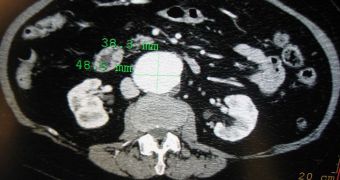Researchers in the United Kingdom are currently working on getting new insight into the causes and possible treatment options for a potentially life-threatening condition called abdominal aortic aneurysm (AAA).
The disease is rather common in elderly men, but it's what doctors would define as “silent.” This means that it does not produce symptoms as it's settling in. It's only later that patients become painfully aware of the fact that they have it.
Experts with the University of Leeds are now working with patients from Yorkshire for collecting more information about AAA. They are using data from the Leeds Aneurysm Development Study (LEADS) for this investigation.
Early conclusions show that this type of aneurysm may be influenced by the way that blood clots. Armed with this knowledge, the Leeds team can now proceed to derive new courses of treatment aimed at slowing down the progress of this condition, or even stop it entirely.
AAA appears when one of the most important blood vessels in the human body, the aorta, literally swells like a balloon. People who develop the condition generally show no symptoms until the aneurysm bursts.
It is possible that some patients with AAA will die in the mean time of other causes, but their chances of being affected by this condition increase with each day their disease goes undiagnosed.
The reason why finding a cure for the disease is so important is the high death toll it takes. About 90 percent of people whose aneurysm bursts die before they reach the hospital, regardless of how prompt emergency responders are.
Conversely, those whose AAA is discovered in time, and undergo the necessary operation, have a 93 to 97 percent survival rate. In the UK, screening for this condition is done in a national program, and as such the number of surgeries carried out on such patients is on the rise.
At this point, no clear factors are known as the cause of aortic aneurysms. Doctors therefore have a very difficult time in figuring out which of their patients will develop the conditions, and which of them are the most likely to die following an aneurysm rupture.
“We have received fantastic support from people across Yorkshire for the LEADS study,” explains University of Leeds professor of vascular surgery Julian Scott.
“Over 1000 patients and control subjects have volunteered to help us with this work and thanks to them, we now have one of the world's largest collections of samples in the UK related to aneurysm development,” he adds.
“Through this work, we are making good progress towards understanding what causes AAA and who is most at risk. Ultimately, we want to improve the treatment of patients with AAA, either through lifestyle changes or drug treatments,” the expert argues.
“But there is still a lot that we don't know and to answer these questions, we need to compare more patients with AAA to people without the condition,” Scott concludes.

 14 DAY TRIAL //
14 DAY TRIAL //